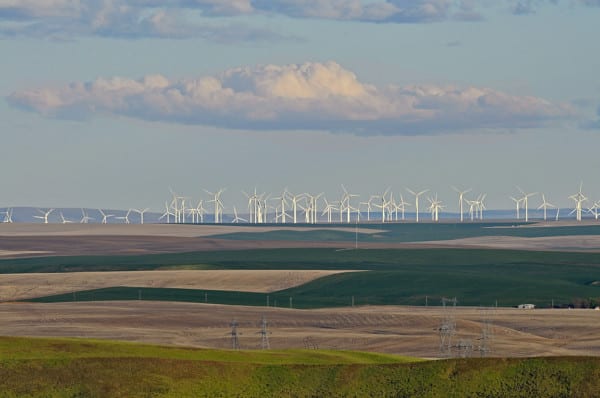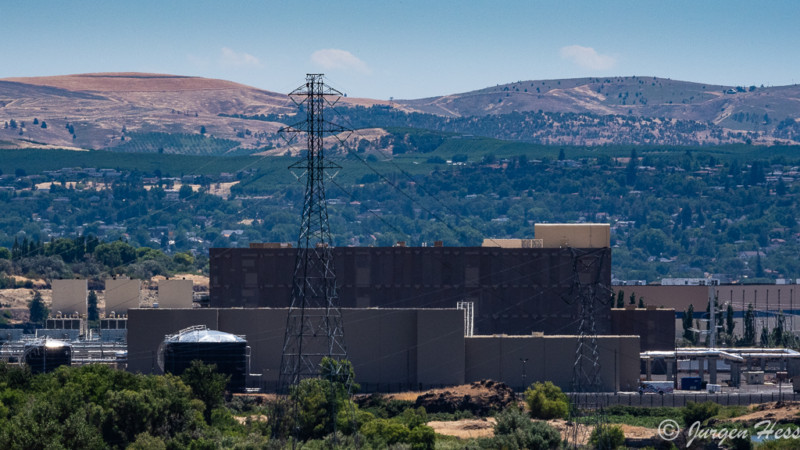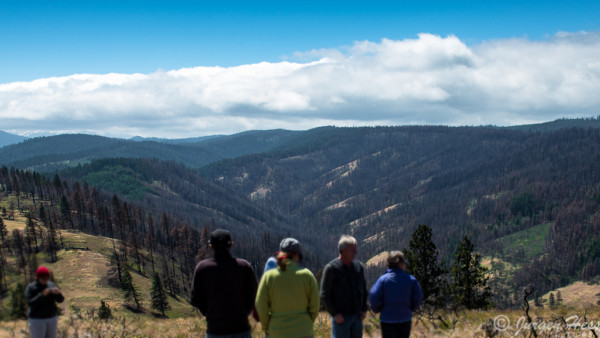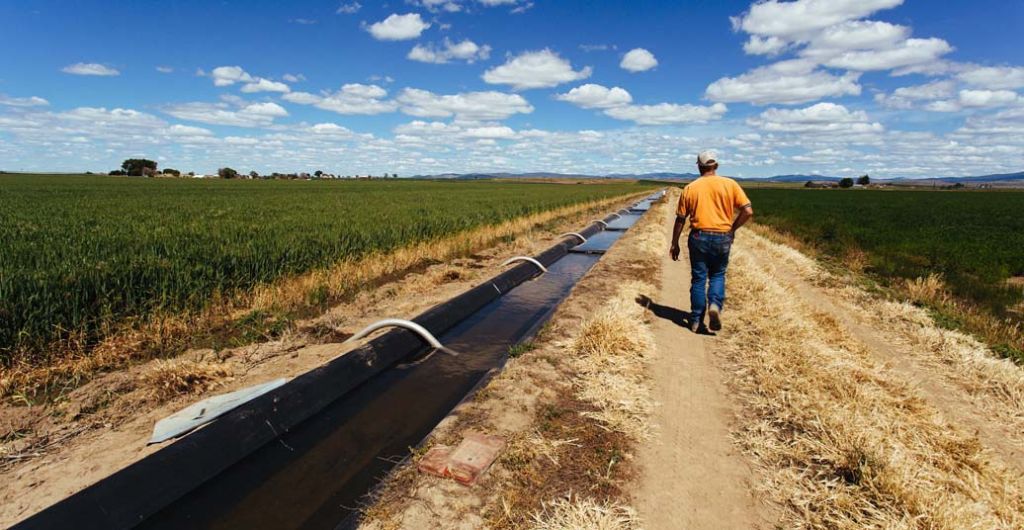By Susanne Wright. July 12, 2018. The Google Data Center in The Dalles, Oregon holds an air of mystery about it. A secretive compound with guarded gates, security fencing, and 24/7 surveillance. From a distance, it is hard to imagine these bland structures are the literal engines of the Information Age, Cyberspace factories, the beating heart of the web. For an internet phenomenon, Google’s campus architecture is curiously unremarkable. Your average big-box store has more charm.
If the exterior of the complex appears overtly utilitarian, it’s because it is designed to be. It’s what’s inside that counts. To safeguard the innovative technology, Google designs and builds its own data centers, and only a few critical Google employees are granted access. Winnie Lam, Google’s Captain of Earthly Elements/Lead for Data Center Sustainability, says the company “incorporates multiple layers of physical security protections. We use?technologies like biometric identification, metal detection, cameras, vehicle barriers, and laser-based instruction detection systems.”
Such spy thriller security deepens the mystery as to why in 2006, Google chose this windy, rocky site. After all, Google’s data centers’ locations are a traveler’s dream: Singapore, Finland, Chile. And. The Dalles? Indeed, The Dalles was Google’s first built-from-scratch data center, which, while interesting, does not answer an equally vexing stumper: What exactly is going on in there?
Google’s choice of The Dalles
“The Dalles has the right combination of infrastructure, developable land, and available workforce for the data center,” Lam says. But if you step back to examine the physical body of a data center, you see that abundant natural resources are its lifeblood. Google is a multinational company built upon its wildly popular search engine, cloud computing, and web apps, but the essential raw material is the stuff of rivers, lakes, and babbling brooks. Water.
At its most basic, a data center is racks upon racks of networked computer servers that store and distribute data. How much data? Google does not provide exact information, but it has been speculated a center can store petabytes to exabytes of data, bigger numbers than most of us can comprehend. Thousands, some sources claim tens of thousands, of servers processing unimaginable stores of data creates tremendous heat, and water is used to chill the building to its optimum temperature of 80 degrees.
Its location alongside the Columbia River led some to speculate that Google draws water from the Columbia River, but in fact, the complex secures all its water directly from the City of The Dalles Public Works and pays a standard rate on consumption. Surprisingly, in this era of climate change and drought, The Dalles Public Works does not place a cap on the amount of water Google can draw. But the company claims that because of its large usage, it carefully estimates its supply needs to prevent drawing more water than necessary.
An NPR article May 8, 2017 mentions that at Google’s data center in Douglas County, Georgia, the company uses grey or recycled wastewater in their cooling systems. Google explains how this works in a March 2012 YouTube video: Smart water use in Google’s Douglas County data center.
Knowing its long-term existence depends on a finite water resource, Google says it designs all its facilities to be water-wise, using one half the water as comparable data centers.
Google’s Lam explains, “At our data centers, we use water as part of the cooling infrastructure for our servers. As with all natural resources, water sustainability is a key consideration at Google. We are constantly looking for ways to most efficiently use water and have a site-specific approach where we work with the local hydrological environment to find the best solutions.
“In The Dalles, we optimize our water use by employing ‘free cooling’ (explained in this video) using outside air most of the year and only use ‘water cooling’ in the warmer months. We also recirculate that water within our system multiple times to get the most out of every drop we use. We partner closely with the City of The Dalles on our estimated water consumption and are investigating ways to partner together on water resilience.”
Powering data centers
If Google finds the City’s abundant water an attractive resource, power generation from Columbia River dams is another. Data centers are some of the most energy-consuming facilities in the world. To meet its electrical power needs, Google procures power from non-Bonneville Power Administration small hydroelectric sources with attached renewable energy certificates, as well as some BPA hydropower.
“Low-impact hydropower can contribute to our clean energy goals,” Lam says. She’s referring to hydropower projects certified by the Low Impact Hydropower Institute (LIHI), a non-profit organization. They certify facilities that “have committed to environmental, cultural and recreational stewardship.”
Lam says that existing hydropower improves the underlying grid mix. Three substations, BPA, North Wasco County PUD, and an onsite Google station, an expansion of an already existing Chenowith substation work in tandem to provide power. Just as with water, Google pays a standard power consumption rate.
Google does not disclose water or energy consumption by site but applies energy-efficient technologies to reach its goal of operating as a carbon neutral company. It recently released a 2017 Environmental Report that covers their global footprint for all of Google’s 15 data centers. Considered an industry leader in sustainability by other data centers, Google states: “Operating our business in an environmentally sustainable way has been a core value since our founding.”
To this end, the company says, “We achieved 100 percent renewable energy for our operations in 2017.” But this is not to say Google powers its data centers with 100 percent renewable energy. That technology does not yet exist. Their report explains this seeming contradiction: “Over the course of 2017, across the globe, for every kilowatt hour of electricity we consumed, we purchased a kilowatt hour of renewable energy from a wind or solar farm that was built specifically for Google.”

Wind turbines in eastern Oregon and Washington send power into the grid via transmission lines like those in foreground. Photo: Jurgen Hess
Neither the City of The Dalles or The Dalles Public Works would comment on Google, and without numbers, it is difficult to know the environmental impact Google has on this region’s water supply, but a recent report states all U.S. data centers combined “were responsible for consumption of 626 billion liters of water in 2014, which includes both water consumed directly at data center sites and water used to generate the electricity that powered them that year.” To put this into perspective, the City of Portland provides approximately 133 billion liters of water a year to its customers: nearly one-quarter of Oregon’s population.
Local connections
The extent to which Google benefits from The Dalles, what does the city get in return? Quite a lot it turns out. In addition to the 200 total jobs it created, the company consistently partnered with the City and surrounding counties, but like the data complex itself, its actions are often not reported to the public. Lam admits the company does little to advertise its regional investments. Cynics may argue that Google, a billion-dollar company, could easily persuade cash-strapped and underemployed cities into giving up too much, but Stephen E. Lawrence, Mayor of The Dalles, is pleased with the partnership.
“We have had very good cooperative efforts working with Google on several infrastructure issues,” he says. “They financed an upgrade to one of our back-up wells, which wasn’t scheduled for upgrade for another five years. This allowed it to be available now. We will reimburse Google at that 5-year time without interest.
“They also helped pay for a major water line to our industrial area, paying for half the costs, only to be repaid whenever an industrial user hooks up and pays its fees. If full payment is not received at the end of a certain time period, the balance is forgiven. Both these projects substantially help the city improve its water security for years of drought and provides additional potential for industrial development.
“Google’s use of electricity helps the city through franchise fees received by the PUD. There are many community projects Google provides funding for: such as free downtown Wi-Fi, technology upgrades at the library, support of STEM (science, technology, engineering and mathematics), wind competition and robotics in our school system.”
Google invested more than $200,000 in First Robotics to expand the program to every public school in five Gorge counties. The company also loans out a portion of their land as part of The Dalles Imagination Garden project and partnership where local students learn about gardening and composting hands-on. All unused produce is donated to a local food bank.
Google pledges to “play a positive role in each of the communities in which we operate around the world.” Locally, the numbers are impressive. Since 2008, Google has awarded over $2 million in grants that impact Wasco County and more than $10 million in grants to Oregon nonprofits and schools.













The use of BPA power through the PUD requires the PUD to find additional power since BPA had no further power to allocate. This means more expensive power and the average ratepayer pays more. Few realize the Gorge wind farms are power users 24/7 but they are not generators 24/7. Their power needs are met through local utilities that must also meet increased demand through expensive power as BPA will not increase their supplies of hydro power. The average rate payer pays. This is another way these facilities and wind farms are financed by the public.
I am glad the author pointed out that Google gets its water from the City. People should realize that the City of TD has a water right to the entire flow of the Dog River, an important salmon tributary to the East Fork of the HOOD RIVER. The City desires to upgrade its existing water line to increase their ability to withdraw more water from this stream potentially further reducing flows in the Dog R. The BPA has provided thousands of $ to rebuild salmon runs in this East Fork . Ironic.